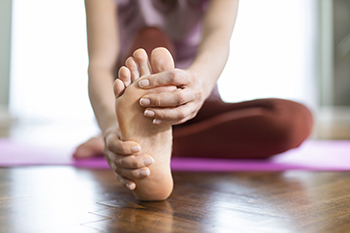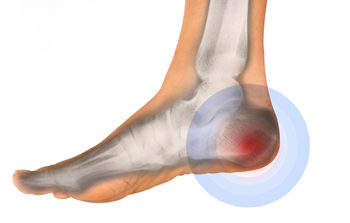Items filtered by date: April 2023
Possible Reasons for Foot Pain

The feet are the workhorses of the body, absorbing shock and force whenever you stand, walk, run, or jump. Because they contain a large number of bones, tendons, muscles, and ligaments, the feet are often at risk for pain. Injury is one of the most common causes of foot pain. This category includes bone fractures, direct trauma, ligament sprains, and muscle or tendon strains. Heel or arch pain is frequently caused by a tearing of the plantar fascia, a band of tissue in the sole of the foot that connects the toes and heels. Heel pain also may be caused by bone spurs, which can be a direct result of plantar fasciitis, or of the thinning of the heel pad as you age. Bunions, hammertoes, and other bone deformities can be another source of foot and toe pain. Gout, which is an inflammatory disease caused by having excess uric acid in the body, can be extremely painful, often targeting the big toe. Nerve problems such as sesamoiditis and Morton’s neuroma are other painful conditions of the feet. If you are experiencing any type of foot pain, it is suggested that you schedule an appointment with a podiatrist who can examine your foot, and diagnose the source before recommending the appropriate treatment options.
Foot Pain
Foot pain can be extremely painful and debilitating. If you have a foot pain, consult with Peter Siroka, DPM from Connecticut. Our doctor will assess your condition and provide you with quality foot and ankle treatment.
Causes
Foot pain is a very broad condition that could be caused by one or more ailments. The most common include:
- Bunions
- Hammertoes
- Plantar Fasciitis
- Bone Spurs
- Corns
- Tarsal Tunnel Syndrome
- Ingrown Toenails
- Arthritis (such as Gout, Rheumatoid, and Osteoarthritis)
- Flat Feet
- Injury (from stress fractures, broken toe, foot, ankle, Achilles tendon ruptures, and sprains)
- And more
Diagnosis
To figure out the cause of foot pain, podiatrists utilize several different methods. This can range from simple visual inspections and sensation tests to X-rays and MRI scans. Prior medical history, family medical history, and any recent physical traumatic events will all be taken into consideration for a proper diagnosis.
Treatment
Treatment depends upon the cause of the foot pain. Whether it is resting, staying off the foot, or having surgery; podiatrists have a number of treatment options available for foot pain.
If you have any questions, please feel free to contact our office located in Stamford, CT . We offer the newest diagnostic and treatment technologies for all your foot care needs.
We Can Treat Your Foot or Ankle Pain
The Many Types of Heel Pain

The heels of the feet endure a great deal of stress and, therefore, are often open to pain and injury. The most common causes of heel pain are plantar fasciitis, Achilles tendonitis, bone spurs, and stress fractures. Heel bursitis, Sever’s disease, and Haglund’s syndrome are other causes that occur less frequently. Pain can be experienced behind the heel, within the bone itself, and under the heel. Simply stepping on a hard rock can cause pain under the heel, but the most common cause is plantar fasciitis. This is an overuse injury to the tissue that runs under the foot and connects the heel to the toes. Chronic plantar fasciitis can also lead to the development of heel spurs on the calcaneus, the main heel bone. Inflammation to the Achilles tendon from overuse is the most frequent cause of pain behind the heel. A podiatrist, a medical doctor who is trained in ailments of the feet and ankles, can diagnose the cause of heel pain by conducting a number of tests. These may include X-rays and electronic imaging tests. If you are suffering from heel pain and are unsure of the cause, it is suggested that you make an appointment with a podiatrist today.
Many people suffer from bouts of heel pain. For more information, contact Peter Siroka, DPM of Connecticut. Our doctor can provide the care you need to keep you pain-free and on your feet.
Causes of Heel Pain
Heel pain is often associated with plantar fasciitis. The plantar fascia is a band of tissues that extends along the bottom of the foot. A rip or tear in this ligament can cause inflammation of the tissue.
Achilles tendonitis is another cause of heel pain. Inflammation of the Achilles tendon will cause pain from fractures and muscle tearing. Lack of flexibility is also another symptom.
Heel spurs are another cause of pain. When the tissues of the plantar fascia undergo a great deal of stress, it can lead to ligament separation from the heel bone, causing heel spurs.
Why Might Heel Pain Occur?
- Wearing ill-fitting shoes
- Wearing non-supportive shoes
- Weight change
- Excessive running
Treatments
Heel pain should be treated as soon as possible for immediate results. Keeping your feet in a stress-free environment will help. If you suffer from Achilles tendonitis or plantar fasciitis, applying ice will reduce the swelling. Stretching before an exercise like running will help the muscles. Using all these tips will help make heel pain a condition of the past.
If you have any questions please contact our office located in Stamford, CT . We offer the newest diagnostic and treatment technologies for all your foot and ankle needs.
Finding Your Shoes for Jazzercise

If you enjoy jazzercise, wearing comfortable and supportive shoes is important. It would be nice if they were attractive shoes, but that should take a back seat to be good for your feet and the activity you are participating in. Attention should be paid to arch support, so feet pronate or strike the floor and correctly distribute weight. If you are at a crossroads regarding the size of the jazzercise shoe, always go a half size up, as the foot will inch forward during high-impact exercise. Shoes should be flexible between the heel and the ball of the foot to accommodate the turns, twists, and jumps done in jazzercise. Also, look for lightweight, breathable shoes that provide support but do not restrict mobility for this activity. If you want assurance in selecting the proper shoes for jazzercise and your feet, it is suggested that you consult with a podiatrist who can help guide you.
It is important to find shoes that fit you properly in order to avoid a variety of different foot problems. For more information about treatment, contact Peter Siroka, DPM from Connecticut. Our doctor will treat your foot and ankle needs.
Proper Shoe Fitting
Shoes have many different functions. They cushion our body weight, protect our feet, and allow us to safely play sports. You should always make sure that the shoes you wear fit you properly in order to avoid injuries and deformities such as: bunions, corns, calluses, hammertoes, plantar fasciitis, stress fractures, and more. It is important to note that although a certain pair of shoes might be a great fit for someone else, that doesn’t mean they will be a great fit for you. This is why you should always try on shoes before buying them to make sure they are worth the investment. Typically, shoes need to be replaced ever six months to one year of regular use.
Tips for Proper Shoe Fitting
- Select a shoe that is shaped like your foot
- Don’t buy shoes that fit too tight, expecting them to stretch to fit
- Make sure there is enough space (3/8” to ½”) for your longest toe at the end of each shoe when you are standing up
- Walk in the shoes to make sure they fit and feel right
- Don’t select shoes by the size marked inside the shoe, but by how the shoe fits your foot
The shoes you buy should always feel as good as they look. Shoes that fit properly will last longer, feel better, and improve your way of life each day.
If you have any questions, please feel free to contact our office located in Stamford, CT . We offer the newest diagnostic and treatment technologies for all your foot care needs.

